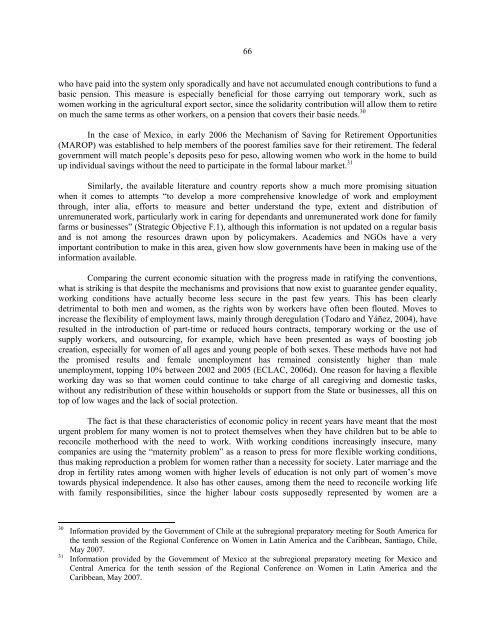Women in Latin America and the Caribbean - Cepal
Women in Latin America and the Caribbean - Cepal
Women in Latin America and the Caribbean - Cepal
You also want an ePaper? Increase the reach of your titles
YUMPU automatically turns print PDFs into web optimized ePapers that Google loves.
66<br />
who have paid <strong>in</strong>to <strong>the</strong> system only sporadically <strong>and</strong> have not accumulated enough contributions to fund a<br />
basic pension. This measure is especially beneficial for those carry<strong>in</strong>g out temporary work, such as<br />
women work<strong>in</strong>g <strong>in</strong> <strong>the</strong> agricultural export sector, s<strong>in</strong>ce <strong>the</strong> solidarity contribution will allow <strong>the</strong>m to retire<br />
on much <strong>the</strong> same terms as o<strong>the</strong>r workers, on a pension that covers <strong>the</strong>ir basic needs. 30<br />
In <strong>the</strong> case of Mexico, <strong>in</strong> early 2006 <strong>the</strong> Mechanism of Sav<strong>in</strong>g for Retirement Opportunities<br />
(MAROP) was established to help members of <strong>the</strong> poorest families save for <strong>the</strong>ir retirement. The federal<br />
government will match people’s deposits peso for peso, allow<strong>in</strong>g women who work <strong>in</strong> <strong>the</strong> home to build<br />
up <strong>in</strong>dividual sav<strong>in</strong>gs without <strong>the</strong> need to participate <strong>in</strong> <strong>the</strong> formal labour market. 31<br />
Similarly, <strong>the</strong> available literature <strong>and</strong> country reports show a much more promis<strong>in</strong>g situation<br />
when it comes to attempts “to develop a more comprehensive knowledge of work <strong>and</strong> employment<br />
through, <strong>in</strong>ter alia, efforts to measure <strong>and</strong> better underst<strong>and</strong> <strong>the</strong> type, extent <strong>and</strong> distribution of<br />
unremunerated work, particularly work <strong>in</strong> car<strong>in</strong>g for dependants <strong>and</strong> unremunerated work done for family<br />
farms or bus<strong>in</strong>esses” (Strategic Objective F.1), although this <strong>in</strong>formation is not updated on a regular basis<br />
<strong>and</strong> is not among <strong>the</strong> resources drawn upon by policymakers. Academics <strong>and</strong> NGOs have a very<br />
important contribution to make <strong>in</strong> this area, given how slow governments have been <strong>in</strong> mak<strong>in</strong>g use of <strong>the</strong><br />
<strong>in</strong>formation available.<br />
Compar<strong>in</strong>g <strong>the</strong> current economic situation with <strong>the</strong> progress made <strong>in</strong> ratify<strong>in</strong>g <strong>the</strong> conventions,<br />
what is strik<strong>in</strong>g is that despite <strong>the</strong> mechanisms <strong>and</strong> provisions that now exist to guarantee gender equality,<br />
work<strong>in</strong>g conditions have actually become less secure <strong>in</strong> <strong>the</strong> past few years. This has been clearly<br />
detrimental to both men <strong>and</strong> women, as <strong>the</strong> rights won by workers have often been flouted. Moves to<br />
<strong>in</strong>crease <strong>the</strong> flexibility of employment laws, ma<strong>in</strong>ly through deregulation (Todaro <strong>and</strong> Yáñez, 2004), have<br />
resulted <strong>in</strong> <strong>the</strong> <strong>in</strong>troduction of part-time or reduced hours contracts, temporary work<strong>in</strong>g or <strong>the</strong> use of<br />
supply workers, <strong>and</strong> outsourc<strong>in</strong>g, for example, which have been presented as ways of boost<strong>in</strong>g job<br />
creation, especially for women of all ages <strong>and</strong> young people of both sexes. These methods have not had<br />
<strong>the</strong> promised results <strong>and</strong> female unemployment has rema<strong>in</strong>ed consistently higher than male<br />
unemployment, topp<strong>in</strong>g 10% between 2002 <strong>and</strong> 2005 (ECLAC, 2006d). One reason for hav<strong>in</strong>g a flexible<br />
work<strong>in</strong>g day was so that women could cont<strong>in</strong>ue to take charge of all caregiv<strong>in</strong>g <strong>and</strong> domestic tasks,<br />
without any redistribution of <strong>the</strong>se with<strong>in</strong> households or support from <strong>the</strong> State or bus<strong>in</strong>esses, all this on<br />
top of low wages <strong>and</strong> <strong>the</strong> lack of social protection.<br />
The fact is that <strong>the</strong>se characteristics of economic policy <strong>in</strong> recent years have meant that <strong>the</strong> most<br />
urgent problem for many women is not to protect <strong>the</strong>mselves when <strong>the</strong>y have children but to be able to<br />
reconcile mo<strong>the</strong>rhood with <strong>the</strong> need to work. With work<strong>in</strong>g conditions <strong>in</strong>creas<strong>in</strong>gly <strong>in</strong>secure, many<br />
companies are us<strong>in</strong>g <strong>the</strong> “maternity problem” as a reason to press for more flexible work<strong>in</strong>g conditions,<br />
thus mak<strong>in</strong>g reproduction a problem for women ra<strong>the</strong>r than a necessity for society. Later marriage <strong>and</strong> <strong>the</strong><br />
drop <strong>in</strong> fertility rates among women with higher levels of education is not only part of women’s move<br />
towards physical <strong>in</strong>dependence. It also has o<strong>the</strong>r causes, among <strong>the</strong>m <strong>the</strong> need to reconcile work<strong>in</strong>g life<br />
with family responsibilities, s<strong>in</strong>ce <strong>the</strong> higher labour costs supposedly represented by women are a<br />
30<br />
31<br />
Information provided by <strong>the</strong> Government of Chile at <strong>the</strong> subregional preparatory meet<strong>in</strong>g for South <strong>America</strong> for<br />
<strong>the</strong> tenth session of <strong>the</strong> Regional Conference on <strong>Women</strong> <strong>in</strong> Lat<strong>in</strong> <strong>America</strong> <strong>and</strong> <strong>the</strong> <strong>Caribbean</strong>, Santiago, Chile,<br />
May 2007.<br />
Information provided by <strong>the</strong> Government of Mexico at <strong>the</strong> subregional preparatory meet<strong>in</strong>g for Mexico <strong>and</strong><br />
Central <strong>America</strong> for <strong>the</strong> tenth session of <strong>the</strong> Regional Conference on <strong>Women</strong> <strong>in</strong> Lat<strong>in</strong> <strong>America</strong> <strong>and</strong> <strong>the</strong><br />
<strong>Caribbean</strong>, May 2007.











